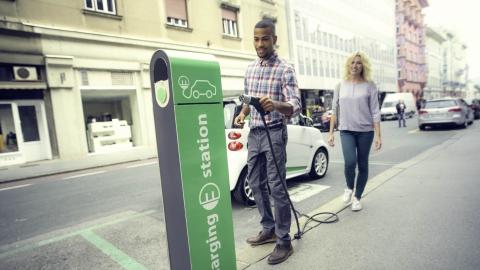
Recent in-depth E Source market research has revealed some striking problems with consumers’ beliefs about electric vehicles (EVs) and how they get “fueled up.” People don’t have many misgivings about the cars themselves, but they have no idea how to charge them. The research starts to explain why people who drive 30 miles or fewer per day (more than 80% of all respondents) seem to think they need a battery that has 350 to 500 miles of range, and why they seem to be suffering from the mysterious affliction we call range anxiety.
Three issues are involved:
If consumers knew most EV owners plug in at home and charge over night, would their image of EVs change? Our prediction is yes.
- People’s only experience with cars to date has been to go to a gas station, put in 10 to 15 gallons of gas, and then be able to drive for 400 miles or so before having to slog back to the ugly, smelly gas station again.
- Most people seem to believe they need to drive to a special, mysterious place called a “charging station” every time they need to charge, which leads to the third issue.
- A majority of people don’t know they can charge at home in their existing garage or driveway with a normal 110-volt outlet if they drive a typical amount each day. According to the 2020 E Source Electric Vehicle Residential Customer Survey, of the respondents who don’t have an EV, only 26% indicated that you can charge a vehicle using a standard three-prong wall outlet when asked how EVs are charged.
Once people actually own an EV, range anxiety concerns go by the wayside and they quickly develop their charging habits. According to our 2019 Residential DER Customer Market Research, 71% of respondents who have an EV typically charge it at home. So why don’t non-EV drivers know that?
The first charging message people get should be related to the comfort and ease of charging at home.
There could be many reasons, but we think it’s because many of the articles and videos about the future of EVs focus on public charging networks. People think they need their cars to go a long way so they don’t run out of power, but if they knew most owners plug in at home and charge over night, would their image of EVs change? Our prediction is yes.
Fortunately, the solutions to this extremely critical problem aren’t too difficult to accomplish:
- First, utility communicators and marketers should make sure that the first charging message people get is related to the comfort and ease of charging at home. The fact that charging at home is almost always going to be the cheapest option is another selling point.
- Second, utilities need to help the EV curious visualize themselves charging at home. Show EV owners charging easily at home, and have them talk about their personal charging habits.
- Third, show how the public charging system is growing and convenient for those rare times you need to fill up on the road. Explain how your utility is helping that network grow.
- Fourth, use plug-in hybrid electric vehicles to bridge the gap while the car market transitions from internal combustion engine vehicles to pure battery EVs. Our research highlighted the important role they can play.
Feeling daunted? Let us help! Email us for information about our in-depth EV research and let us explain how we can help you successfully promote EVs in your service territory. E Source members can submit a question through our Ask E Source program (PDF).